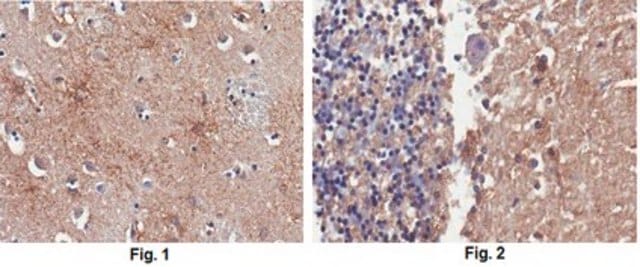MAB1596
Anti-Post Synaptic Density Protein 95 Antibody, clone 6G6-1C9
clone 6G6-1C9, Chemicon®, from mouse
Synonim(y):
PSD-95
About This Item
Polecane produkty
pochodzenie biologiczne
mouse
Poziom jakości
forma przeciwciała
purified immunoglobulin
rodzaj przeciwciała
primary antibodies
klon
6G6-1C9, monoclonal
reaktywność gatunkowa
mouse, rat, bovine
producent / nazwa handlowa
Chemicon®
metody
immunocytochemistry: suitable
immunohistochemistry: suitable
western blot: suitable
izotyp
IgG2a
numer dostępu NCBI
numer dostępu UniProt
Warunki transportu
dry ice
docelowa modyfikacja potranslacyjna
unmodified
informacje o genach
bovine ... Dlg4(100137840)
mouse ... Dlg4(13385)
rat ... Dlg4(29495)
Opis ogólny
Specyficzność
Immunogen
Zastosowanie
Representative image from a previous lot.
Confocal fluorescent analysis of PC12 using MAb1596 Mouse mAB (Red). Actin filaments have been labeled with Alexa Fluor 488 -Phalloidin (Green). Nuclear is stained with DAPI (Blue). Membrane staining positive.
Immunocytochemistry:
12.5 µg/mL
Western Blot:
1-5 μg/mL (ECL) on rat brain lysate (20 μg).
Optimal working dilutions must be determined by the end user.
Neuroscience
Synapse & Synaptic Biology
Jakość
Opis wartości docelowych
Powiązanie
Postać fizyczna
Przechowywanie i stabilność
Handling Recommendations: Upon first thaw, and prior to removing the cap, centrifuge the vial and gently mix the solution. Aliquot into microcentrifuge tubes and store at -20°C. Avoid repeated freeze/thaw cycles, which may damage IgG and affect product performance. Note: Variabillity in freezer temperatures below -20°C may cause glycerol containing solutions to become frozen during storage.
Komentarz do analizy
Mouse brain, rat brain tissue.
Inne uwagi
Informacje prawne
Oświadczenie o zrzeczeniu się odpowiedzialności
Not finding the right product?
Try our Narzędzie selektora produktów.
polecane
Kod klasy składowania
10 - Combustible liquids
Klasa zagrożenia wodnego (WGK)
WGK 2
Certyfikaty analizy (CoA)
Poszukaj Certyfikaty analizy (CoA), wpisując numer partii/serii produktów. Numery serii i partii można znaleźć na etykiecie produktu po słowach „seria” lub „partia”.
Masz już ten produkt?
Dokumenty związane z niedawno zakupionymi produktami zostały zamieszczone w Bibliotece dokumentów.
Nasz zespół naukowców ma doświadczenie we wszystkich obszarach badań, w tym w naukach przyrodniczych, materiałoznawstwie, syntezie chemicznej, chromatografii, analityce i wielu innych dziedzinach.
Skontaktuj się z zespołem ds. pomocy technicznej








